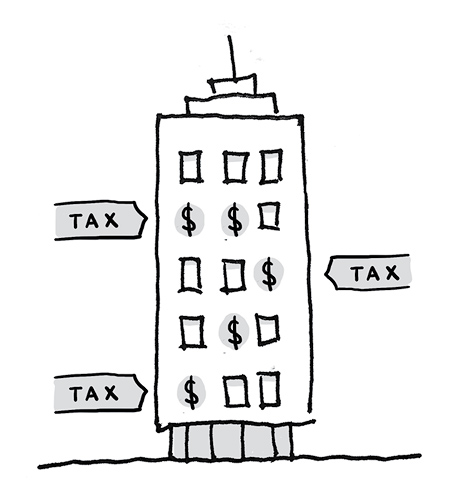19.4. Speculation Tax
Aus Pattern Language Wiki
In addition to Multi-Family Infill and other affordability tool patterns, taxation incentives and disincentives are needed,
Problem-statement: Speculative investment in real estate can fuel financial bubbles, hurting an entire economy and everyone in it. But a healthy return on real estate investments is necessary to ensure a vibrant and livable city.
Discussion: Examples of real estate speculative bubbles and the damage they can cause are common throughout history, but perhaps nowhere more conspicuous than the 2008 global financial crisis. Lending and tax rules allowed (and helped to fuel) irrational increases in prices, decreasing affordability for neighboring residents — until the entire system collapsed, leaving many homes empty and many lives irreparably damaged.
More recently many cities have seen surges in speculative investments in their urban cores, fueling a sharp rise in prices. Vancouver, British Columbia has seen such a rise, and has sought tools to dampen the speculation that fuels it. In many cases, foreign investors are seeking assets in order to “park” their capital, and they are often drawn to tall residential buildings — sometimes dubbed “safety deposit boxes in the sky.” In other cases, investors seek to purchase rental properties and force renters to pay significantly more, thereby contributing to overall rises in rent prices.
To dampen these forms of speculation, both Vancouver and the province of British Columbia have introduced new forms of taxation. In British Columbia, empty residences owned by foreign nationals, and other “satellite families” based primarily in other countries and not paying local taxes, are subject to a “speculation and vacancy tax” of 2% of assessed value.¹ In addition, non-primary residences in Vancouver, British Columbia that sit empty for more than six months are charged an “empty homes tax” equal to 1% of their assessed value.² These taxes create a strong disincentive against “parking” and speculating on local real estate.
A tax of this kind must not be seen as a “silver bullet,” but rather, part of a system of incentives and disincentives that reward positive “externalities” to promote the common good — like a more affordable housing market (see Externality Valuation, 17.3).
Therefore:
Change taxation policy to disincentivize speculative investments in real estate, particularly for empty units.
Use this tool in conjunction with a suite of other tools and strategies. …
¹ See https://www2.gov.bc.ca/gov/content/taxes/property-taxes/speculation-and-vacancy-tax
² See https://vancouver.ca/home-property-development/empty-homes-tax.aspx
Image: Bobanny via Wikimedia Commons.
Mehaffy, M. et al. (2020). SPECULATION TAX (pattern). In A New Pattern Language for Growing Regions. The Dalles: Sustasis Press. Available at https://pattern-language.wiki/.../Speculation_Tax
SECTION I:
PATTERNS OF SCALE
1. REGIONAL PATTERNS
Define the large-scale spatial organization…
1.4. 400M THROUGH STREET NETWORK
2. URBAN PATTERNS
Establish essential urban characteristics…
3. STREET PATTERNS
Identify and allocate street types…
4. NEIGHBORHOOD PATTERNS
Define neighborhood-scale elements…
5. SPECIAL USE PATTERNS
Integrate unique urban elements with care…
6. PUBLIC SPACE PATTERNS
Establish the character of the crucial public realm…
7. BLOCK AND PLOT PATTERNS
Lay out the detailed structure of property lines…
8. STREETSCAPE PATTERNS
Configure the street as a welcoming place…
9. BUILDING PATTERNS
Lay out appropriate urban buildings…
10. BUILDING EDGE PATTERNS
Create interior and exterior connectivity…
10.1. INDOOR-OUTDOOR AMBIGUITY
SECTION II:
PATTERNS OF MULTIPLE SCALE
11. GEOMETRIC PATTERNS
Build in coherent geometries at all scales…
11.2. SMALL GROUPS OF ELEMENTS
12. AFFORDANCE PATTERNS
Build in user capacity to shape the environment…
13. RETROFIT PATTERNS
Revitalize and improve existing urban assets …
14. INFORMAL GROWTH PATTERNS
Accommodate “bottom-up” urban growth…
15. CONSTRUCTION PATTERNS
Use the building process to enrich the result…
SECTION III:
PATTERNS OF PROCESS
16. IMPLEMENTATION TOOL PATTERNS
Use tools to achieve successful results…
16.2. ENTITLEMENT STREAMLINING
16.3. NEIGHBORHOOD PLANNING CENTER
17. PROJECT ECONOMICS PATTERNS
Create flows of money that support urban quality…
17.4. ECONOMIES OF PLACE AND DIFFERENTIATION
18. PLACE GOVERNANCE PATTERNS
Processes for making and managing places…
18.3. PUBLIC-PRIVATE PLACE MANAGEMENT
19. AFFORDABILITY PATTERNS
Build in affordability for all incomes…
19.1. INTEGRATED AFFORDABILITY
20. NEW TECHNOLOGY PATTERNS
Integrate new systems without damaging old ones…
20.2. RESPONSIVE TRANSPORTATION NETWORK COMPANY

